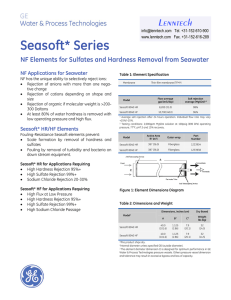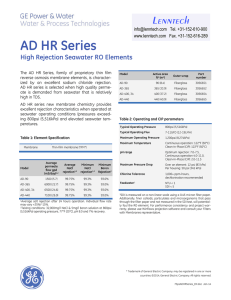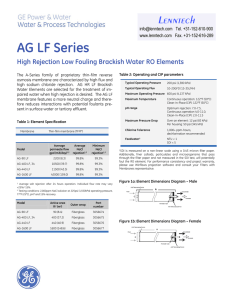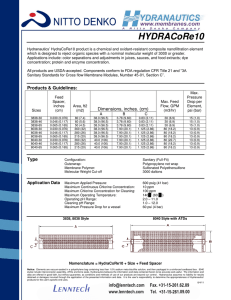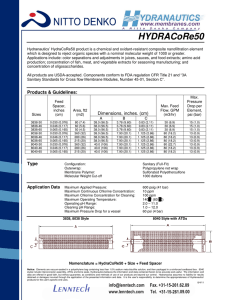Seasoft* Series NF Elements for Sulfates and Hardness Removal from Seawater
advertisement
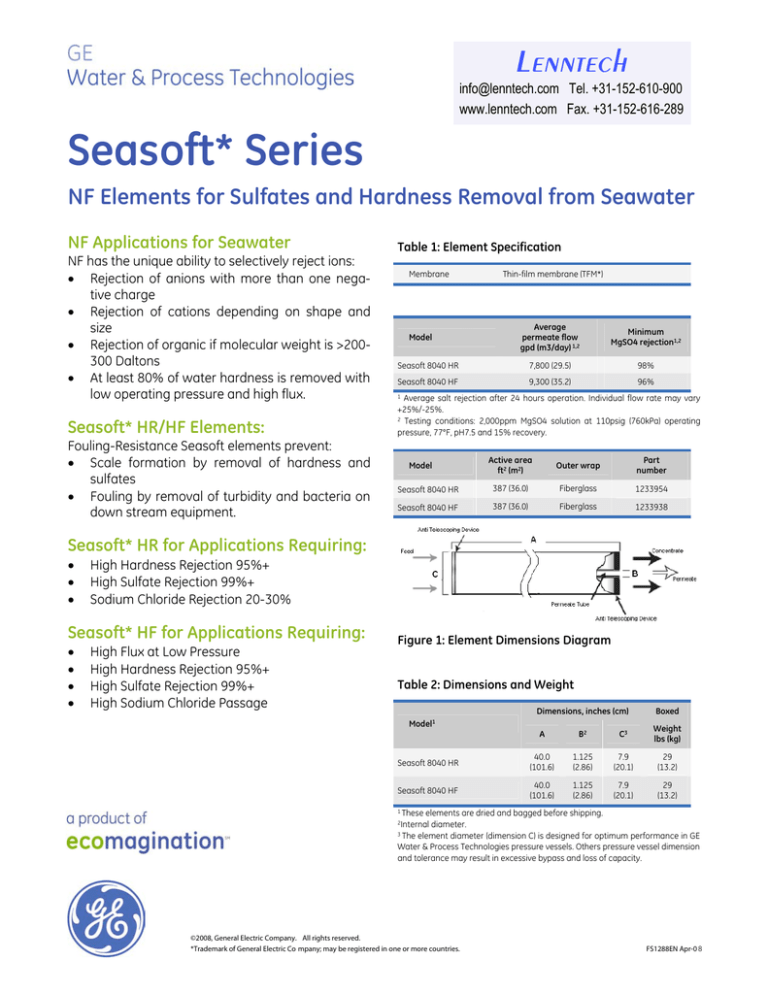
Lenntech info@lenntech.com Tel. +31-152-610-900 www.lenntech.com Fax. +31-152-616-289 Seasoft* Series NF Elements for Sulfates and Hardness Removal from Seawater NF Applications for Seawater NF has the unique ability to selectively reject ions: • Rejection of anions with more than one negative charge • Rejection of cations depending on shape and size • Rejection of organic if molecular weight is >200300 Daltons • At least 80% of water hardness is removed with low operating pressure and high flux. Seasoft* HR/HF Elements: Fouling-Resistance Seasoft elements prevent: • Scale formation by removal of hardness and sulfates • Fouling by removal of turbidity and bacteria on down stream equipment. Table 1: Element Specification Membrane Thin-film membrane (TFM*) Average permeate flow gpd (m3/day) 1,2 Minimum MgSO4 rejection1,2 Seasoft 8040 HR 7,800 (29.5) 98% Seasoft 8040 HF 9,300 (35.2) 96% Model Average salt rejection after 24 hours operation. Individual flow rate may vary +25%/-25%. 2 Testing conditions: 2,000ppm MgSO4 solution at 110psig (760kPa) operating pressure, 77°F, pH7.5 and 15% recovery. 1 Active area ft2 (m2) Outer wrap Part number Seasoft 8040 HR 387 (36.0) Fiberglass 1233954 Seasoft 8040 HF 387 (36.0) Fiberglass 1233938 Model Seasoft* HR for Applications Requiring: • • • High Hardness Rejection 95%+ High Sulfate Rejection 99%+ Sodium Chloride Rejection 20-30% Seasoft* HF for Applications Requiring: • • • • High Flux at Low Pressure High Hardness Rejection 95%+ High Sulfate Rejection 99%+ High Sodium Chloride Passage Figure 1: Element Dimensions Diagram Table 2: Dimensions and Weight Dimensions, inches (cm) Model1 Boxed A B2 C3 Weight lbs (kg) Seasoft 8040 HR 40.0 (101.6) 1.125 (2.86) 7.9 (20.1) 29 (13.2) Seasoft 8040 HF 40.0 (101.6) 1.125 (2.86) 7.9 (20.1) 29 (13.2) 1 These elements are dried and bagged before shipping. diameter. 3 The element diameter (dimension C) is designed for optimum performance in GE Water & Process Technologies pressure vessels. Others pressure vessel dimension and tolerance may result in excessive bypass and loss of capacity. 2Internal ©2008, General Electric Company. All rights reserved. *Trademark of General Electric Co mpany; may be registered in one or more countries. FS1288EN Apr-0 8 Table 3: Operating and CIP parameters Typical Operating Pressure 70-400psig (483-2,758kPa) Typical Operating Flux 10-15GFD (15-25LMH) Maximum Operating Pressure 600psig (4,140kPa) Maximum Temperature Continuous Operation: 122°F (50°C) Clean-In-Place (CIP): 104°F (40°C) pH Range Continuous Operation: 3.0-9.0, Clean-In-Place (CIP): 2.0-10.5 Maximum Pressure Drop Over an element: 12psi (83 kPa) Per housing: 50psi (345 kPa) Chlorine Tolerance 500+ ppm-hours, dechlorination recommended Feedwater NTU < 1 SDI < 5 Lenntech info@lenntech.com Tel. +31-152-610-900 www.lenntech.com Fax. +31-152-616-289 Page 2 FS1288EN Apr-08
